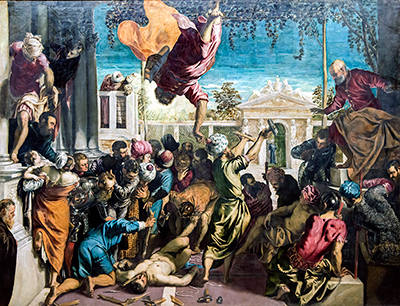This biography unveils the unusual route taken by Jacopo Tintoretto towards becoming one of the finest exponents of Renaissance painting
Tintoretto would always live in the shadow of his hero, fellow-Venetian, Titian. Having been rejected by the great man in attempting to earn an apprenticeship, he would set about stubbornly proving him wrong.
The artist had been taken by his father to Titian's studio after showing early promise in several artistic disciplines. Sadly, his style was considered too ingrained and divergent from traditional Venetian methods to enable him to join the group. This setback served as motivation for the artist to succeed and he created his own small studio where he later employed several members of his extended family.
Tintoretto can be considered a professional artist from around his early twenties though he never became wealthy from this past time. In offering his services around Venice at highly competitive prices he was able to pick up plenty of commissioned pieces but never lift himself up, financially.
His father, Giovanni Battista Robusti, was a cloth-dryer who encouraged his son to pursue his own passion. Aside from emotional support he was not really able to supply his son with anymore help within his careeer. Thankfully, his son held a stubborn character and great set of natural skills which was enough to ultimately produce an impressive ouevre.
Tintoretto studied various Italian Renaissance masters during his early lifetime, aiming to make up for missing out on a prestigious apprenticeship. He also found that his existing skills as a sculptor and draughtsman would also add his painting methods. It was specifically with his colour that Titian so impressed this young Venetian, whilst Michelangelo's drawings were also studied in great depth.
Some have suggested influences from Giovanni Bellini, Giorgione and Annibale Carracci but there still remains many question marks from the early years of Tintoretto's life. We do know that he would complete most of his work for local Venetian institutions such as church altarpieces, civic buildings or personal portraits of various high ranked individuals.
Tintoretto's style was undoubtably unique, with a great depth to his work which made every painting feel like a major event. He would also add movement to his figures, in most cases, and provde a more aggressive colour scheme that would grab a viewer's attention straight away. It was as if his sculptures were being placed into his paintings, adding a three dimensional energy to the Mannerist movement.
Most of his work was rich in colour, making use of reds, golds and greens before the last two decades, where things moved to a darker contrast. His version of The Last Supper, for example, slowly drifts into a background of darkness and mystery.




